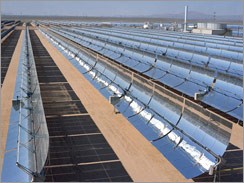
A public utility company is an organization that maintains the infrastructure for a public service. Public utilities are subject to forms of public control and regulation ranging from local community-based groups to statewide government monopolies.
Southern Company is an American gas and electric utility holding company based in the Southern United States. It is headquartered in Atlanta, Georgia, with executive offices also located in Birmingham, Alabama. The company is the second largest utility company in the U.S. in terms of customer base, as of 2021. Through its subsidiaries it serves 9 million gas and electric utility customers in 6 states. Southern Company's regulated regional electric utilities serve a 120,000-square-mile (310,000 km2) territory with 27,000 miles (43,000 km) of distribution lines.

The U.S. Energy Information Administration (EIA) is a principal agency of the U.S. Federal Statistical System responsible for collecting, analyzing, and disseminating energy information to promote sound policymaking, efficient markets, and public understanding of energy and its interaction with the economy and the environment. EIA programs cover data on coal, petroleum, natural gas, electric, renewable and nuclear energy. EIA is part of the U.S. Department of Energy.

Constellation Energy Corporation is an American energy company headquartered in Baltimore, Maryland. The company provides electric power, natural gas, and energy management services. It has approximately two million customers across the continental United States.

The energy policy of the United States is determined by federal, state, and local entities. It addresses issues of energy production, distribution, consumption, and modes of use, such as building codes, mileage standards, and commuting policies. Energy policy may be addressed via legislation, regulation, court decisions, public participation, and other techniques.

Enmax Corporation is a vertically integrated utility with operations across Alberta, Canada, and in Maine, U.S. Through its subsidiaries, ENMAX Power Corporation and Versant Power, ENMAX owns and operates transmission and distribution utilities that deliver electricity to customers in Calgary, Alberta, and northern and eastern Maine. Through ENMAX Energy Corporation, ENMAX owns and operates power generation facilities and offers electricity and natural gas products and services to residential, commercial and industrial customers across Alberta.
The Texas electricity market is deregulated, meaning that there is competition in the generation and distribution of electricity. Power generators in the Texas Interconnection, managed by the Electric Reliability Council of Texas, participate in an energy-only electricity market and are compensated only for the electricity they produce. The wholesale generation market was deregulated in 1995 and the distribution market in 1999, with Texas Senate Bill 7. This replaced the prior system in which power was generated and consumed locally by the same utility with one in which retail providers contracted with generators across the state.
The Public Utilities Commission of Ohio (PUCO) is the public utilities commission of the U.S. state of Ohio, charged with the regulation of utility service providers such as those of electricity, natural gas, and telecommunications as well as railroad safety and intrastate hazardous materials transport.

Southern Company Gas, formerly AGL Resources, is an American Fortune 500 energy services holding company headquartered in Atlanta, Georgia. The company's operations consist of natural gas distribution, wholesale services, retail operations, and midstream operations. Southern Company Gas is one of the largest natural gas distribution companies in the United States. The company serves approximately 4.5 million utility customers through its regulated distribution subsidiaries across four states. Southern Company Gas made the Fortune 500 list in 2015, Forbes 2000 in 2006, and is a member of the S&P 500 Index. In 2016, Southern Company acquired AGL Resources and renamed it Southern Company Gas.
FortisBC is a Canadian owned, British Columbia based regulated utility providing natural gas, and electricity. FortisBC has approximately 2,600 employees serving more than 1.2 million customers in 135 B.C. communities and 58 First Nations communities across 150 Traditional Territories.

Community Choice Aggregation (CCA), also known as Community Choice Energy, municipal aggregation, governmental aggregation, electricity aggregation, and community aggregation, is an alternative to the investor-owned utility energy supply system in which local entities in the United States aggregate the buying power of individual customers within a defined jurisdiction in order to secure alternative energy supply contracts. The CCA chooses the power generation source on behalf of the consumers.
Atlanta Gas Light Company (AGLC), commonly still known as Atlanta Gas Light (AGL), is the largest natural gas wholesaler in the Southeast U.S., and is the leading subsidiary of parent company Southern Company Gas. It was founded in 1856 and is headquartered in Atlanta, as is Southern Company Gas. It provides distribution and metering to more than 1.6 million residential, commercial, and industrial customers in 243 communities throughout the state of Georgia.

PECO, formerly the Philadelphia Electric Company, is an energy company founded in 1881 and incorporated in 1929. It became part of Exelon Corporation in 2000 when it merged with Commonwealth Edison's holding company Unicom Corp.

IGS Energy, also known as Interstate Gas Supply, Inc., is an independent retail natural gas and electric supplier based in Dublin, Ohio, United States. It serves more than 1,000,000 residential, commercial and industrial customers in the states of Ohio, Michigan, Kentucky, New York, Pennsylvania, Indiana, Virginia, Maryland, Texas, California and Illinois. The company was founded in 1989, and today employs more than 900 people across 18 states.
There is a large array of stakeholders that provide services through electricity generation, transmission, distribution and marketing for industrial, commercial, public and residential customers in the United States. It also includes many public institutions that regulate the sector. In 1996, there were 3,195 electric utilities in the United States, of which fewer than 1,000 were engaged in power generation. This leaves a large number of mostly smaller utilities engaged only in power distribution. There were also 65 power marketers. Of all utilities, 2,020 were publicly owned, 932 were rural electric cooperatives, and 243 were investor-owned utilities. The electricity transmission network is controlled by Independent System Operators or Regional Transmission Organizations, which are not-for-profit organizations that are obliged to provide indiscriminate access to various suppliers to promote competition.

Net metering is a policy by many states in the United States designed to help the adoption of renewable energy. Net metering was pioneered in the United States as a way to allow solar and wind to provide electricity whenever available and allow use of that electricity whenever it was needed, beginning with utilities in Idaho in 1980, and in Arizona in 1981. In 1983, Minnesota passed the first state net metering law. As of March 2015, 44 states and Washington, D.C. have developed mandatory net metering rules for at least some utilities. However, although the states' rules are clear, few utilities actually compensate at full retail rates.
Vermont electric power needs are served by over twenty utilities. The largest is Green Mountain Power, a subsidiary of Énergir which recently also took over Central Vermont Public Service. Together this single company represents 70% of the retail customers in Vermont. The state is a small electricity consumer compared with other states. Therefore, its electricity sector has the lowest carbon footprint in the country. As of 2010, the state had the lowest wholesale electricity costs in New England. Efficiency Vermont engages in aggressive initiatives to cut residential electricity waste, which often identifies other problems that it claims can save hundreds per household per year. Accordingly, Vermont's overall energy bills are also relatively lower than in the rest of the New England states.

Energy in California is a major area of the economy of California. California is the state with the largest population and the largest economy in the United States. It is second in energy consumption after Texas. As of 2018, per capita consumption was the fourth-lowest in the United States partially because of the mild climate and energy efficiency programs.

Gas South, based in Atlanta, Georgia, United States, is a natural gas provider that serves more than 425,000 residential, commercial and governmental customers in Georgia, Florida, North Carolina, South Carolina, New Jersey and Ohio.

A consumer green energy program is a program that enables households to buy energy from renewable sources. By allowing consumers to purchase renewable energy, it simultaneously diverts the utilization of fossil fuels and promotes the use of renewable energy sources such as solar and wind.












